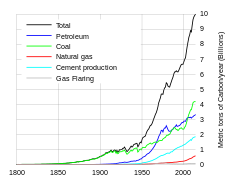From Wikipedia, the free encyclopedia
Avoiding dangerous climate change (also expressed with equivalent terms such as preventing dangerous anthropogenic interference with the climate system) is a major objective of both scientific research and in international governmental development of climate policy.
The concept expressed by these phrases was central to the "IPCC Second Assessment: Climate Change 1995" published by the International Panel on Climate Change.[1] In 2002, the United Nations Framework Convention on Climate Change (UNFCCC),[2] an international organization established by treaty in 1992, incorporated the concept as the focus of its formal Framework Convention policy:
- "ARTICLE 2. OBJECTIVE. The ultimate objective of this Convention and any related legal instruments that the Conference of the Parties may adopt is to achieve, in accordance with the relevant provisions of the Convention, stabilization of greenhouse gas concentrations in the atmosphere at a level that would prevent dangerous anthropogenic interference with the climate system. Such a level should be achieved within a time-frame sufficient to allow ecosystems to adapt naturally to climate change, to ensure that food production is not threatened and to enable economic development to proceed in a sustainable manner." (Emph. added)[3]
Setting temperature rise goals
Limiting the average global surface temperature increase of 2°C (3.6°F) over the pre-industrial average has, since the 1990s, been commonly regarded as an adequate means of avoiding dangerous climate change, in science and policy making.[13][14] However, recent science has shown that the weather, environmental and social impacts of 2°C rise are much greater than the earlier science indicated, and that impacts for a 1°C rise are now expected to be as great as those previously assumed for a 2°C rise.[11] In a July 2011 speech, climate scientist Kevin Anderson explained that for this reason, avoiding dangerous climate in the conventional sense is no longer possible, because the temperature rise is already close to 1°C, with effects formerly assumed for 2°C.[15][16] Moreover, Anderson's presentation demonstrates reasons why a temperature rise of 4°C by 2060 is a likely outcome, given the record to date of action on climate, economic realities, and short window of time remaining for limiting the average surface temperature rise to 2°C or even 3°C.[15] He also states that a 4°C rise would likely be an unstable state, leading to further increases in following decades regardless of mitigation measures that may be taken.[15]The consequences of failing to avoid dangerous climate change have been explored in two recent scientific conferences: the 4 degrees and beyond climate change conference held at Oxford University in 2009; and the Four Degrees Or More? Australia in a Hot World held at the University of Melbourne in July 2011.
Symposium on avoiding dangerous climate change
In 2005 an international conference called "Avoiding Dangerous Climate Change: A Scientific Symposium on Stabilisation of Greenhouse Gases"[17] examined the link between atmospheric greenhouse gas concentration, and the 2 °C (3.6 °F) ceiling on global warming thought necessary to avoid the most serious effects of global warming. Previously, this had generally been accepted as being 550 ppm[18]The conference took place under the United Kingdom's presidency of the G8, with the participation of around 200 'internationally renowned' scientists from 30 countries. It was chaired by Dennis Tirpak and hosted by the Hadley Centre for Climate Prediction and Research in Exeter, from 1 February to 3 February.[19]
Objectives

Global average surface temperature 1880 to 2009, with zero point set at the average temperature between 1961 and 1990.
The conference was called to bring together the latest research into what would be necessary to achieve the objective of the 1992 United Nations Framework Convention on Climate Change:
- to achieve, in accordance with the relevant provisions of the Convention, stabilization of greenhouse gas concentrations in the atmosphere at a level that would prevent dangerous anthropogenic interference with the climate system.
Specifically, the conference explored three issues:
- For different levels of climate change what are the key impacts, for different regions and sectors and for the world as a whole?
- What would such levels of climate change imply in terms of greenhouse gas stabilisation concentrations and emission pathways required to achieve such levels?
- What options are there for achieving stabilisation of greenhouse gases at different stabilisation concentrations in the atmosphere, taking into account costs and uncertainties?[21]
The symposium's conclusions
Among the conclusions reached, the most significant was a new assessment of the link between the concentration of greenhouse gases in the atmosphere and the increase in global temperature levels. Some researchers have argued that the most serious consequences of global warming might be avoided if global average temperatures rose by no more than 2 °C (3.6 °F) above pre-industrial levels (1.4 °C above present levels). It had generally been assumed that this would occur if greenhouse gas concentrations rose above 550 ppm carbon dioxide equivalent by volume. This concentration was, for example, informing government in certain countries, including the European Union.[22]The conference concluded that, at the level of 550 ppm, it was likely that 2 °C would be exceeded, according to the projections of more recent climate models. Stabilising greenhouse gas concentrations at 450 ppm would only result in a 50% likelihood of limiting global warming to 2 °C, and that it would be necessary to achieve stabilisation below 400 ppm to give a relatively high certainty of not exceeding 2 °C.[23]
The conference also claimed that, if action to reduce emissions is delayed by 20 years, rates of emission reduction may need to be 3 to 7 times greater to meet the same temperature target.[23]
Proceedings of the symposium were published in 2011, in an open-access special issue of the Royal Society's Philosophical Transactions A.[24]

